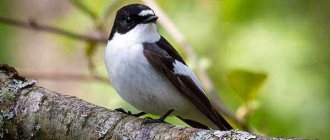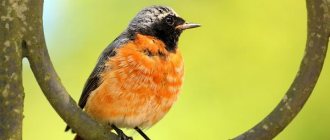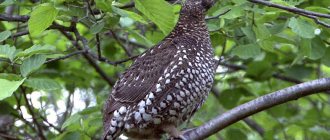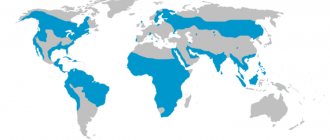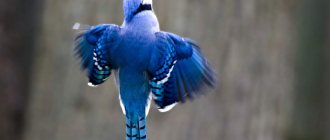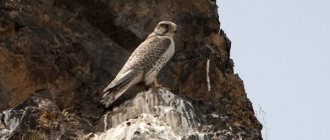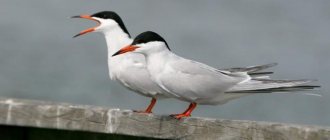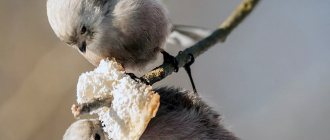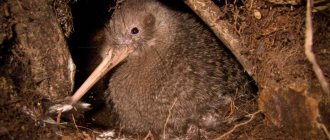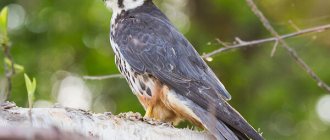| Latin name: | Falco vespertinus |
| English name: | To be confirmed |
| Kingdom: | Animals |
| Type: | Chordata |
| Class: | Birds |
| Squad: | Falconiformes |
| Family: | Falcons |
| Genus: | Falcons |
| Body length: | 28-33 cm |
| Wing length: | 23-35 cm |
| Wingspan: | 65-77 cm |
| Weight: | 130—197 g |
- 4.1 Amur or eastern falcon (Falco amurensis)
Description of the bird
The falcon is a small falcon, which in its proportions and way of life resembles a kestrel, but differs from it in its narrow wings. The bird's body length is from 28 to 33 cm, wing length is 23-35 cm, wingspan is from 65 to 77 cm, weight ranges from 130 to 197 g. The beak is short and weak.
Plumage
— Advertising —
The plumage of the male is dark gray (almost black) in color with a brick-reddish tint to the belly, undertail and “pants”. The female is ocher in color with gray transverse stripes on the back, wings and tail, her belly is decorated with longitudinal streaks, and black “whiskers” are noticeable on her face. The young are brownish in color with a light belly covered with longitudinal streaks. The legs, cere and ocular ring of falcons are red or orange; in young birds they are yellow. The claws are whitish-brown in color. The iris is dark brown.
What types of birds are they similar to?
The falcon is almost indistinguishable from the falcon in appearance; it is an exact miniature copy of its older relative. In photographs, birds are practically indistinguishable without size references. Only birds sitting nearby can be identified by size.
In flight, a falcon can easily be mistaken for a wild pigeon, and only an experienced hunter can determine which one is in the air. The falcon differs from the wood pigeon, or vitiutnaya, only in that it has slightly more powerful claws and a slightly more curved beak.
Hobby and falcon are another pair of small predators of the falcon family that are often confused. But they can be distinguished by the most obvious feature: the Hobby has black claws, and the Red Falcon has light claws.
What does it eat?
Falcons, like all birds of prey, prefer animal food. However, due to their rather modest size, these small falcons hunt primarily for large insects, such as dragonflies or large beetles. In their wintering places, which are located in Africa, birds readily eat locusts.
If for some reason there are no insects in the habitat of the falcon, then the birds begin to hunt for small rodents. In such cases, falcons feed mainly on mice, and also add lizards and small snakes to their diet. In addition, sparrows, and in more rare cases, even such large birds as pigeons, become prey for the falcon.
— Advertising —
The Latin species name of the falcon “vespertinus” is translated as “evening”, but the bird hunts mainly during daylight hours, during the day.
The feeding behavior of the falcon not only does not harm agricultural crops, but, on the contrary, helps to obtain more harvest, since the small falcon actively destroys insects, beetles, locusts, and the falcon does not allow birds that peck at crops into its hunting territory.
Falcons are kept in captivity and fed in the same way as other species of birds of prey. At home, red falcons are convenient because they become almost omnivores and easily get used to a wide variety of foods.
Red falcon at home, what to keep, what to feed
Due to the special beauty of the birds, pagan priests loved to tame them. And now, knowing how to catch a coccyx, it is very easy to accustom him to life in captivity. Although they belong to a proud family, they have a very weak sense of neighbor. They are not attached to the nest, the female and the cubs, so you can easily catch them and not feel remorse. The only periods when the falcon should not be separated from the female are incubation and the early stage of feeding the chicks. The female never leaves the clutch; the male brings her food. The male also feeds the hatched chicks, and after a while the female joins in. But then you can safely take any bird and accustom it to life in a cage.
The cage should be large, with metal bars. You cannot limit a bird's desire to fly. There is no need to be afraid that a falcon that has gained freedom will run away - these birds very easily get used to humans and often show touching love for their owner. Chicks that were taken at an age when their plumage was still downy become especially tame.
You shouldn’t feed a bird grain – it’s not its food. Beetles, laboratory mice, boiled meat, pork or beef liver are ideal for her. The predator will also peck homemade food such as pizza or sandwiches, but it is not worth disturbing its digestion in this way.
The falcon takes any food in its fist, which looks especially funny if you watch the process of eating beetles. The falcon sucks out the insides of the insect and throws out the empty chitinous shell.
Where do they live?
The main distribution area of the red falcon is the forest-steppe of Eurasia, starting from Eastern Europe and the Balkan Peninsula in the west and up to the Vilyui River basin, the Lena River and the coast of Lake Baikal in the east. To the east lives a related species of falcon, the Amur falcon.
Falcons are migratory birds. In winter, they migrate en masse to the south of the African continent, and partly to the south of Asia. The flight is always carried out in large flocks, unlike other representatives of the falcon family.
Falcons usually nest in abandoned nests of crows or magpies, less often in hollows, niches, and burrows. Birds form large colonies with up to 100 pairs. They return from their wintering grounds by May, and fly away quite early - in August. Falcons breed late, since their nesting period is closely related to the breeding time of locusts and other insects.
falco_cuculo_3.jpg
Photo: wikipedia.org/Ferdinando sacchetti
Despite its small size, the red falcon has a perky, courageous and even slightly “impudent” disposition. According to some observations, in an effort to conquer a profitable nesting territory, a tiny falcon can enter into single combat with a heron. Falcons often live in colonies numbering from tens to hundreds of pairs, for example, in residential or abandoned rookeries. These are birds with a highly developed social system - if danger threatens the clutch or chicks, then all adult birds will bravely defend their own. Red falcons are very responsible parents. A male will never abandon a female who is sitting on eggs or raising chicks. He will catch as much prey as the family needs.
In the nesting colonies, the backbone of the future migratory flock is formed, which heads south in early October. The falcon is well adapted to a temperate continental climate, but cannot withstand even light frosts, preferring to spend the winter in warm countries. They return to their nesting sites by mid-April. Their favorite biotopes are open: steppes, forest-steppes, farmlands. But the falcon does not settle in large forest areas - its flight is not adapted to maneuvering between trees.
Common types
Amur or eastern falcon (Falco amurensis)
In size and lifestyle, the species is very similar to the common falcon, but differs from it in plumage. The Amur falcon is painted in lighter colors, its distinctive feature being bright white cheeks. The bird's belly is also white and spotted. In males, the undersides of the wings are partly white. Females and juveniles are distinguished by a dark gray head with a white throat and cheeks. The feathers on the legs and undertail area are also white.
The species, according to its name, is widespread in the Far East (northeast China, eastern Mongolia, North Korea). In Russia, the bird is found in Transbaikalia, the Amur region and Primorye. For the winter, like the common falcon, it migrates to southern Africa, while the birds fly about 10,000 km.
The main diet of the Amur falcon is insects. The bird nests either in trees or in hollows. For life, he prefers to choose forest-steppes and the outskirts of high mountains, where there is both space for flight and the opportunity to obtain food.
Nutrition
Dragonflies, beetles, and grasshoppers are the main food preferred by these birds of prey. The falcon is also capable of attacking lizards or small rodents (mice); among birds it preys on sparrows and pigeons. These representatives of birds are active only during the day and return to their nests at dusk.
The falcon bird flies over the steppes, fields and meadows. Seeing prey on the ground, it hovers over it, flapping its wings frequently, then dives sharply and grabs an insect or lizard. If the beetle has managed to move, then the bird catches up with it on foot. Falcons rarely grab prey on the fly, but behave like real falcons.
These birds hunt all day long, destroying a large number of harmful insects and rodents, which brings great benefits to the national economy.
Male and female: main differences
Sexual dimorphism in the falcon is manifested in the dark gray, almost black color of the plumage of the male, whose abdomen, undertail and “pants” are brick-reddish in color. The female is lighter in plumage, ocher and gray tones predominate in her color, there are also transverse stripes on the back, wings and tail, and longitudinal streaks on the tummy; the face of the females is decorated with black “whiskers”.
Reproduction
Falcons arrive at their nesting sites late, in May, so their mating season begins immediately at this time.
The female lays 3 to 6 eggs, which she incubates for a period of 25 to 28 days. All this time, the female does not leave the clutch for a minute, and the male takes care of her and brings her food. It is during this period, when the female falcon is incubating the eggs, that you can hear the sound of the male falcon’s song, which he makes during the hunt.
At the beginning of July, falcon chicks are already on their wings and until mid-August they fly well and can get their own food. Thus, by the time they migrate to Africa for the winter, young birds have already become full members of the flock and lead an independent life.
The lifespan of falcons ranges from 12 to 16 years; in captivity, birds often live longer. Thus, in Africa, every season local residents tame several birds, and over several years they “gather” their own flock, which does not return to their native lands and protects crops from invasions of locusts, voles and small birds. Such “domesticated” falcons live up to 18 years.
Red Falcon - Falco vespertinus
Phylum Chordata Chordata Subphylum Vertebrates Verterbrata Class Birds Aves Order Falconiformes Falconiformes Family Falconidae
Falco vespertinus Linnaeus, 1766 KhĔRKHI (= ćERÇI HURCHKI, KhĔРХŸ)
Status. I category. Endangered species. Included in the IUCN Red Book (NT ver 3.1 - 2001), Appendix 3 of the Red Book of the Russian Federation, Appendix II of CITES, the Bonn and Berne Conventions, a bilateral agreement between the Government of Russia and the Government of India on the protection of migratory birds and their habitats. Protected in many European countries - included in the European Community Directive No. 79/409 on the conservation of wild bird species (BD Annex I). Has environmental status in Europe (SPEC 3). Description. A small falcon, smaller than a dove. The weight of males is 120-190, females - 130-200 g, body length - 27-33, wingspan - 65-78 cm. The color of the male is dark gray, almost black, the “pants” and undertail are brick-red. The female has a bright red underside and the same cap; the upperparts are gray with distinct brown transverse streaks. They nest colonially or singly, most often in active or abandoned rook colonies. There are 3-6 eggs in a clutch. According to Zhitkov B.M. and Buturlina S.A. (1906), in the first half of summer, mice and voles form the food of this falcon, and in the second half, orthoptera. Arrives in April - May, departs in September - November. Inhabits forest, forest-steppe and part of the steppe zones from Karelia and the Carpathians to Lake Baikal. The distribution of the falcon is fragmentary: in some places it is found frequently and constantly, and in others it is completely absent. During the nesting period in Chuvashia there is one registration in the Poretsk region. During the migration period, red falcons were observed in open habitats (fields, floodplains) in the Cheboksary, Alatyr, Vurnar, Ibresinsky, Shemurshinsky, Yadrinsky districts and in the city of Cheboksary. In the former Simbirsk province (in the valley of the Sura River), in the second half of August, birds gathered in pre-flight flocks of enormous numbers. Included in the Red Books of the Republics of Mari El (II category), Tatarstan (II category), Mordovia (I category), Ulyanovsk (I category) and Nizhny Novgorod (category B) regions. Habitats. A typical forest-steppe bird. It nests in small copses, forest belts, on the outskirts of clearings, swamps, and fires. Number and trends of its change. In the 20th century The number of falcon in most regions of Russia decreased. Presumably, 1-5 pairs nest in the republic. During the migration period they are observed mainly singly. On May 18, 1993, a pair of birds was observed near the Shomikovskaya colony of gray herons. In 2008, in one day (06.09) a falcon was seen at 3 points: 1 adult male and 13 young birds (Ibresinsky district, floodplain of the Khoma River), 1 young bird (Vurnarsky district, floodplain of the Sredny Tsivil River), 1 adult male and 3 young birds (Vurnarsky district, floodplain of the Bolshoi Tsivil River). Main limiting factors. Disturbance factor during the nesting period. Poaching. Breeding. No breeding activities were carried out in the republic. Security measures taken. It is protected on the territory of the Alatyrsky section of the Prisursky Nature Reserve and in its protective zone, in the Chăvash Vărmanĕ National Park, and in the Kalininsky State Nature Reserve. Necessary security measures. Identification of nesting sites and organization of their protection. Sources of information: Zhitkov, Buturlin, 1906; Ashmarin, 1950; Grigoriev et al., 1977; Ignatiev, Pavlov, 1993; Arzamastsev et al., 1997; Glushenkov et al., 1997; Lastukhin, 1997; Lastukhin, Kogan, 1997; List of animals and plants. CITES, 1998; Ilyashenko, 2001; Ryabitsev, 2001; Ignatiev, Yakovlev V., 1997; Antipov, 1998; Belousova et al., 2008; compilers' data. Compiled by: Isakov G.N., Voronov L.N., Dimitriev A.V.
The falcon (Falco vespertinus) is a bird of the order Falconiformes, listed in the Red Book of the Moscow Region.
A small falcon, smaller than a dove. The color of males is uniform dark gray with red-brown “pants” and undertail. Females are colored differently - the back is gray with dark transverse streaks, the underside of the body and the “cap” are red. The young ones have brownish-gray upperparts, dirty white underparts, and a black mask and “mustache” on their heads.
Quite loud. The voice is similar to the voices of other falcons and consists of repeated high loud calls “ki-ki-ki-ki...”.
Distributed in the forest, forest-steppe zone from Eastern Europe to Eastern Siberia. For nesting they choose small forests, copses, and forest belts. They often nest colonially, occupying rook settlements. In the steppe and forest-steppe zones it is a fairly common bird. In the forest zone, although it reaches the middle and northern taiga, it is very rare everywhere.
The main food is large insects. They very rarely feed on small birds and rodents.
Migratory. Wintering grounds are located in South Africa.
They arrive at nesting sites late, usually in May. They nest both singly and in colonies. In case of single nesting, the pair uses old nests of crows and magpies. The clutch usually contains 3-5 ocher-colored eggs, densely covered with brown, reddish and brown spots. Both male and female incubate. Incubation lasts just over 20 days. While the chicks are small, only the male hunts and brings prey; later the female joins him. Broods stay in place for a long time and you can observe whole flocks of migratory falcons sitting along the roads on wires. This social behavior is not characteristic of most birds of prey. Departure for wintering takes place in August – September.
The low abundance is most likely directly related to the biological and ecological characteristics of the species. Optimal living conditions are located south of the Moscow region, in the steppe and forest-steppe zones.
Photo - Murat Akuner
Interesting Facts
- Falcons can attack a heron, but not as prey for food, but only in order to take the heron’s nest.
- Falcons are social birds; they live in colonies; males take care of females during the nesting period. However, it is possible to catch and tame a falcon at any time, except during the egg incubation period. These little falcons have a peaceful, docile nature, they are easy to tame, but since they love to fly, they can fly away from their owner. In ancient times, falcons had their wings clipped because of this. However, there are many examples of how people found a wounded falcon, nursed it and released it, and the bird returned back, and even with prey.
- Falcons bring many benefits to people. They destroy large numbers of grasshoppers and other insect pests, which helps in preserving crops. Falcons are especially useful when there is a sharp increase in the number of rodents and harmful insects.
- Today, the falcon population is constantly decreasing. The main reason for this is the chemicals that people use to irrigate fields. The feeding area of birds is also reduced, which has a bad effect on their reproduction. Falcons are listed in the Red Book and require serious protection. Today they are internationally recognized as a rare species, and Fr. In many countries, hunting falcon shooting is prohibited by law.
Natural habitat
The species is found in all types of open areas bordered by plantings or with sparse trees, where numerous populations of prey, especially insects, are found. These include:
- steppes and wooded steppes;
- gallery forests along river banks crossing meadows;
- swamps or swamps, peat bogs;
- drained and irrigated fields;
- large forest clearings;
- burnt areas;
- parks, gardens, groves (even within cities);
- foothills of the mountains
Falcons do not build nests, the colonial tendencies of the species shift the choice of habitat towards areas where large birds (for example, corvids) previously bred; suitable nests are seasonally vacated, preferably in the crowns of tall, densely growing trees of any species, broad-leaved or coniferous.
Overhead wires, poles and other structures use falcons to rest between insect hunting sessions.
